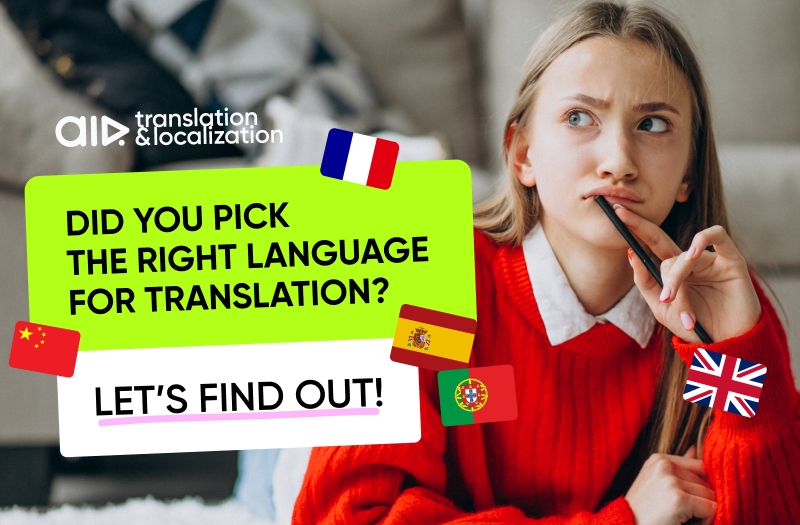Table of contents
So, you've decided to translate your YouTube content into another language. Great move! Content translation and localization open up new audiences, bring in more views, and, ideally, increase revenue. But how do you know if it's actually working?
So, you've decided to translate your YouTube content into another language. Great move! Content translation and localization open up new audiences, bring in more views, and, ideally, increase revenue. But how do you know if it's actually working?
The success of a translated channel depends on the same content marketing metrics as your main one. But in the early stages, specific indicators can tell you if you've picked the right language or if something needs adjusting.
The Technical Side of Audio Tracks: Why Your Metrics Might Be Misleading
Before diving into specific content marketing success metrics, let's talk about one big technical factor that can throw off your analysis: YouTube’s handling of audio tracks.
Audio tracks have been around for a while, but sometimes they behave unpredictably. We've tested this extensively, often launching 10 translated channels and seeing underwhelming results on 1 or 2 of them. In most cases, it wasn’t the content or the translation itself causing low engagement but the way YouTube’s algorithm handled the audio.
Trying to solve this problem, we took existing translated audio tracks and added them to another translated channel’s videos. As a result, those tracks sometimes even outperformed the original, bringing in 45% more views.
Therefore, if your translated videos aren't performing well, it’s not always about poor content adaptation — it could be a technical issue. If you're unsure, consult experts who have tested these variables at scale.
Now, let’s move to content marketing metrics that matter when measuring the success of translated content.
Hundreds of creators have translated their content with AIR Media-Tech. As a YouTube-recommended vendor for translation and localization, AIR ensures top-quality service tailored to your growth. Reach out to us to learn more!
Did You Choose the Correct Language?
Translating content into a new language isn’t just about reaching more people — it’s about reaching the right people. If you’ve picked the wrong language, no amount of optimization will help. Here’s what to track:
Traffic Sources: Is There Already an Audience?
One of the easiest ways to check if a language is worth translating into is by looking at your traffic sources in YouTube Analytics. If a significant portion of your existing audience comes from a specific country or region, it’s a green flag to test content translation and localization for this specific market.

If you already have organic engagement from that region, a translated channel is more likely to succeed because the demand already exists. If not, you might need to test the waters before committing.
Topic Popularity in the Region
Even if your content is a hit in one language, that doesn’t mean it will be in another. Before investing in content translation, use tools like Google Trends, YouTube Analytics, or VidIQ to check demand in your target region. If your niche is practically nonexistent in the language, your videos might struggle no matter how well they’re translated.
Competitor Analysis: Is There a Market?
Look at local creators. Are there thriving channels in your niche? If not, it could mean two things:
- An untapped opportunity — you could be the first to dominate.
- A cultural barrier — your content may not resonate with the local audience.
In this case, the only thing you can do is check by trial and error.
Is Your Content Ranking in the New Language?
You might have picked the right language, but if your videos aren’t being discovered, you won’t see results. Here’s how to check:
YouTube SEO
Are your translated videos ranking for relevant keywords? If not, there is a chance you need to refine your SEO translated content strategy, optimizing titles, descriptions, and tags for the new language.
Click-Through Rate (CTR)
Low CTR? If you didn’t have this problem on your original channel, then your localization might be off. Translated titles and thumbnails need to be just as compelling as your originals. Sometimes, direct translations don’t work — test different versions to see what gets more clicks.
For example, you have a channel with subliminal messages. However, the Japanese-speaking market might not be very familiar with the term 'subliminal,' so they might not click on your video. In this situation, you could try using a more descriptive title like 'silent affirmations.'
YouTube Recommendations
If YouTube isn’t recommending your translated content, it may not see it as relevant. A low percentage here means you need to tweak your metadata or work on increasing engagement signals.

How to Identify Poorly Performing Dubbing
A bad content translation can kill engagement. Even if your content ranks well, poor voiceovers can drive viewers away. Here’s how to spot the problem:
Audience Retention
If retention drops significantly compared to the original video, your voiceover might sound unnatural, robotic, or lacking emotion. A dull or lifeless dub makes people leave.
Consider working with native-speaking voice actors or using AI dubbing tools that offer more expressive and natural-sounding speech.

Comments and Feedback
Are viewers mentioning the dubbing? Complaints about voices sounding off or translations being awkward are red flags that your content translation and localization process needs improvement.
If you see comments like "The voice sounds too robotic" or "The emotions don’t match the scene," it’s a sign that your dubbing might be too flat or poorly synced.
Viewer Return Rate
Are people watching one video and never coming back? If managing translated content isn’t leading to repeat viewers, check whether the dubbing feels engaging and culturally relevant. Test different voiceover styles, adjust tone, or even tweak the script to better resonate with local audiences. Retention rates often improve when the translation feels natural and conversational.
Should You Keep Investing in Translation?
If you've been translating content for a while, how do you know if it's worth continuing? Here’s what to track:
Monetization: RPM & CPM
Some languages have lower CPM rates, meaning you might get more views but earn less. This can be a major factor in deciding whether translation is financially viable. Track both RPM (Revenue per Mille) and CPM to see if the revenue per thousand views makes sense for your efforts. If the CPM is too low, you may need to explore alternative monetization strategies, such as sponsorships or localized affiliate marketing, to make the channel profitable before scaling further.
Subscriber Growth in the New Region
If you’ve uploaded multiple translated videos but aren’t seeing subscriber growth, something’s off. Either the cultural content adaptation isn’t working, or the market isn’t interested. You may want to contact experts like the AIR Translate team, who have already launched hundreds of localized channels and will work out the problem for you.
Brand Engagement
Are local advertisers or sponsors reaching out? If not, it could be a sign that your content isn’t resonating in that region. A lack of brand interest often means low audience loyalty.
Consult Experts?
If your translated content isn’t performing as expected, don’t panic. Sometimes, the issue is technical. Other times, it’s the choice of language, topic, or the translation quality itself. Track the right metrics for content marketing and tweak your strategy.
And remember — just because something works in one language doesn’t mean it’ll work in another. To be more sure when choosing a language to translate your content into, contact us at AIR Media-Tech. We worked on some of the most popular translation cases on YouTube, such as Brave Wilderness, Kids Diana Show, and Amelka Karamelka.






